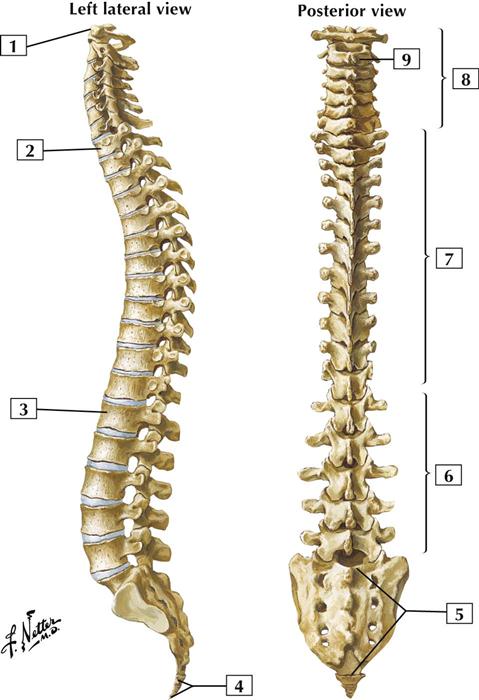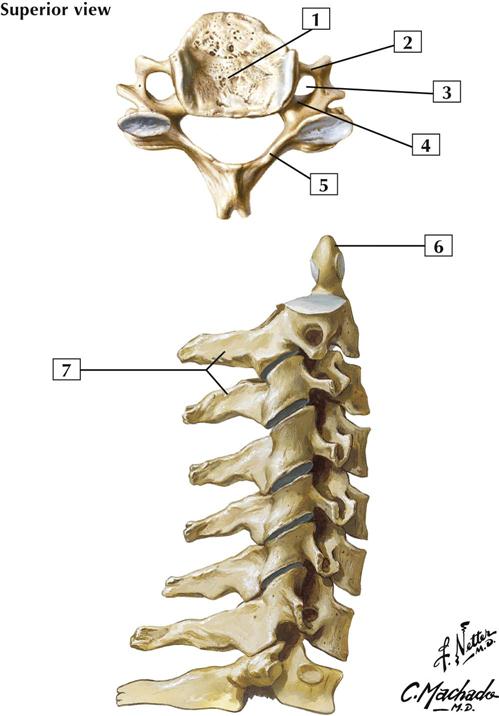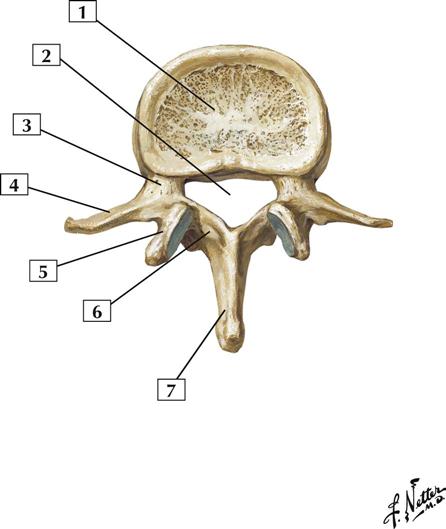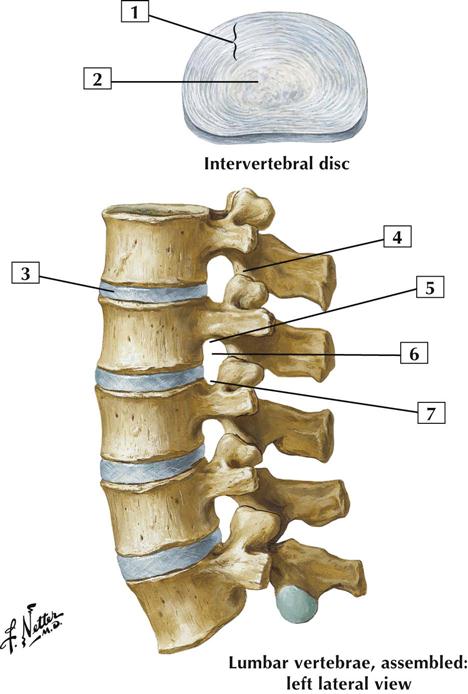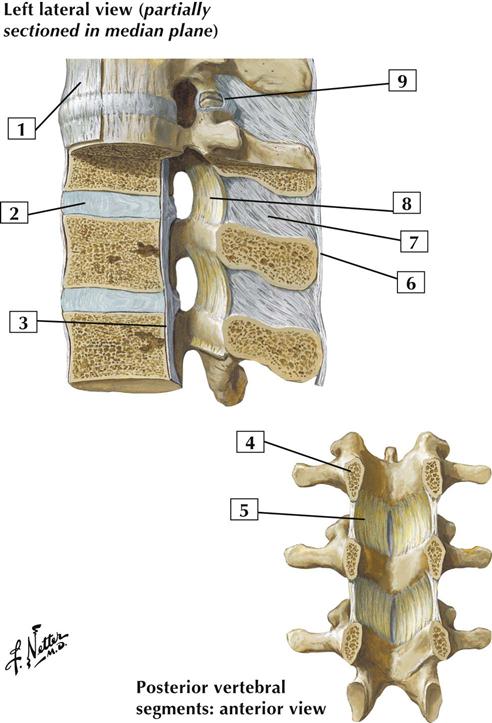Back and Spinal Cord
Cards 2-1 to 2-21
Bones and Joints
2-1 Vertebral Column
Comment:
Typically, the vertebral column comprises 7 cervical, 12 thoracic, 5 lumbar, 5 sacral (fused), and 4 coccygeal (last 3 fused) vertebrae.
Primary curvatures of the vertebral column include the thoracic curvature and sacral curvature. Secondary curvatures include the cervical curvature and lumbar curvature. Secondary curvatures develop during infancy as children begin to bear the weight of the head, sit up, stand, and support their own weight.
The cervical and lumbar spine allow for greater movement than the other regions of the vertebral column.
Note from the illustration that intervertebral discs separate individual bodies of the adjacent vertebrae (except between the first 2 cervical vertebrae, called the atlas and axis, and the fused sacrum and coccyx).
Atlas Plate 153
See also Plates 21, 183, 243
2-2 Cervical Vertebrae
Comment:
The first 2 cervical vertebrae are the atlas and axis (see Section 1, Head and Neck for a description).
The cervical spine allows for considerable movement.
A typical cervical vertebra has a body, pedicle, lamina, and spinous process.
The transverse processes of the cervical vertebrae contain the transverse foramen, which allows for passage of the vertebral vessels.
The lower illustration shows the articulated cervical vertebrae from C2 to C7 and the 1st thoracic vertebra. The 7th cervical vertebra is called the vertebra prominens because of its long spinous process. The intervertebral discs between adjacent vertebrae have been removed.
Atlas Plate 15, 20
2-3 Thoracic Vertebrae
Comment:
Typical thoracic vertebrae have costal facets. The superior costal facet articulates with the head of the corresponding rib, the inferior facet articulates with the rib below, and the transverse costal facet articulates with the tubercle of the corresponding rib.
The body, pedicle, and lamina enclose the vertebral foramen, which houses the spinal cord and its meningeal coverings.
The spinous processes of the thoracic vertebrae are long and oriented posteriorly.
The thoracic region of the spine allows for some movement but is constrained by the articulation of the ribs to the vertebrae posteriorly and the sternum anteriorly.
Atlas Plate 154
2-4 Lumbar Vertebra
Comment:
Typical lumbar vertebrae have large bodies and massive transverse processes. They support the weight of the trunk and provide attachment sites for muscles of the trunk and back.
The lumbar region of the spine allows for considerable movement (flexion, extension, lateral bending, and rotation). Although lumbar vertebrae have long transverse processes for muscle attachment, they do not articulate with ribs.
Atlas Plate 155
2-5 Lumbar Vertebrae
Comment:
Intervertebral discs form secondary cartilaginous joints (symphyses) between the bodies of 2 adjacent vertebrae. They are present from the axis to the sacrum, but there are no discs between the atlas and axis (C1 and C2). They serve as shock absorbers. A disc consists of a central nucleus pulposus surrounded by a fibrocartilaginous anulus fibrosus.
Adjacent inferior and superior vertebral notches form an intervertebral foramen that allows a spinal nerve to exit.
The joints of the vertebral arches are plane synovial joints between the superior and inferior articular processes (facets) that allow for some gliding or sliding movement.
Atlas Plate 155
2-6 Vertebral Ligaments: Lumbar Region
Comment:
Intervertebral discs form secondary cartilaginous joints (symphyses) between the bodies of adjacent vertebrae. They are secured by the anterior and posterior longitudinal ligaments. There is no disc between the atlas and axis.
Ligaments of the vertebral column include the anterior and posterior longitudinal ligaments. The former run along the anterior surfaces of the vertebral bodies. The latter run along the posterior surfaces. The ligamentum flavum connects adjacent laminae and limits flexion. Supraspinous (limit flexion) and interspinous (weak ligaments) ligaments run between adjacent spinous processes.
The anterior longitudinal ligaments limit extension of the vertebral column; the posterior longitudinal ligaments limit flexion. The anterior longitudinal ligament is stronger than the posterior longitudinal ligament. The ligamenta flava help support an upright posture.
Atlas Plate 159
2-7 Sacrum and Coccyx

